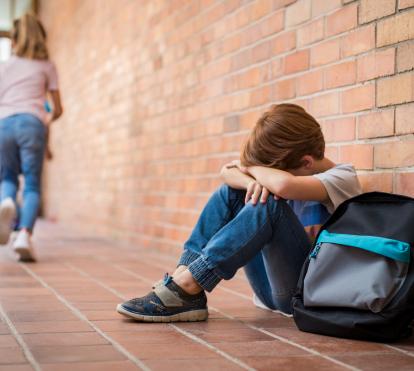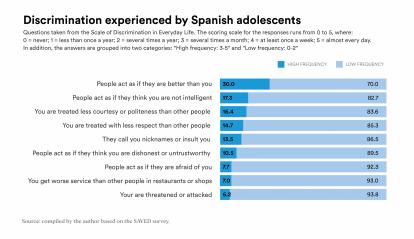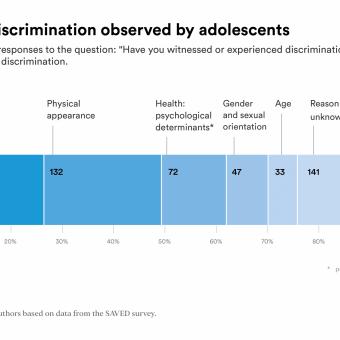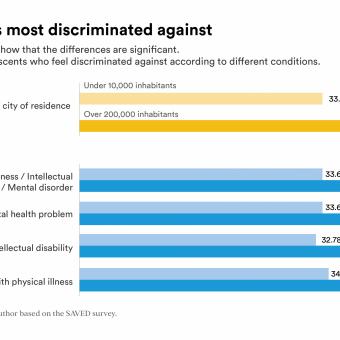
More than half of adolescents have witnessed other young people being subjected to discrimination
05.05.25
5 minutes readThe study Stigma and discrimination as vulnerability factors in adolescence, promoted by the Social Observatory of the ”la Caixa” Foundation, analyses these two variables, which often affect young people and can be key factors in the vulnerability of this group.
The 54,3% of adolescents have witnessed acts of discrimination against some of their peers, mainly in the form of taunts or insults. This discrimination is most often in the educational environment and is carried out by adolescents themselves.
Among the main causes of discrimination observed by these young people are factors such as belonging to an ethnic minority (noted by 26% of respondents); issues related to physical appearance, including obesity, clothing or height (23%); gender or sexual orientation (8%); health of peers, whether physical or mental; psychological aspects, such as academic ability or certain personality traits (13%). Finally, in 25% of cases, the cause of discrimination is unknown, as illustrated in the following chart:

This is confirmed by the study entitled Stigmatisation and discrimination as vulnerability factors in adolescence, promoted by the Social Observatory of the ”la Caixa” Foundation and led by researchers Clara González Sanguino, Jairo Rodríguez Medina, Alba Ayuso Lanchares, Elena Betegón Blanca, Lorena Valdivieso León and María Jesús Irurtia Muñiz, from the University of Valladolid. The results are based on an online survey of 1,000 Spanish adolescents between the ages of 12 and 16.
“When we asked adolescents whether they had witnessed discrimination, more than half recounted various experiences, with the most frequent causes being belonging to racialised groups, for example, not allowing someone to play because they are Moroccan; physical appearance, such as mocking a boy for being overweight or having health issues; and psychological factors, like laughing at a peer because of a disability or due to their gender or sexual orientation,” explained the study’s lead author, Clara González.
The report also reveals that between 15% and 30% of the adolescents surveyed state that they are often discriminated against “more frequently by their peers and, to a much lesser extent, by strangers, teachers or family members,” as the researcher pointed out. This means they are belittled in contexts where others behave as if they are superior to them. Furthermore, 17.3% of the young respondents report that people often act as if they think they are not intelligent, and 16.4% say they are treated with less courtesy or politeness than others.
The results of this study also indicate that 13.5% of adolescents are frequently subjected to name-calling or insults, and 6.2% report being threatened or physically assaulted at least several times a month. These findings are illustrated in the following chart, which also highlights other situations experienced by the surveyed youths:

“In the day-to-day discrimination questionnaire, up to 30% of adolescents acknowledged that others acted as if they were superior to them, with occurrences ranging from once a day to several times a month, and 13.5% reported frequently being called names or insulted. This is complemented by the experiences they recounted,” noted González.
The main causes identified in the discrimination experienced include age, physical appearance and height or body weight, followed by family economic status or mental health issues. Other significant factors encompass aspects related to the academic environment and personality, as well as gender and sexual orientation.
The report, promoted by the Social Observatory of the ”la Caixa” Foundation, also indicates that adolescents surveyed who live in large cities (with over 200,000 inhabitants) report experiencing significantly higher levels of discrimination compared to those residing in small towns (with fewer than 10,000 inhabitants).
“When comparing groups, we found that adolescents with a mental disorder, physical illness or intellectual disability, as well as those who have more contact with these conditions, experience higher levels of discrimination than those who do not. Additionally, another factor studied was living in large cities (over 200,000 inhabitants) versus small towns (fewer than 10,000), making it possible to identify particularly vulnerable groups of young people,” stated the lead author.
Similarly, adolescents who have a disability, physical illness or mental health issue – or who have family members or friends with such conditions – also report experiencing significantly more discrimination than those without these problems. The following chart illustrates these differences among adolescents:

Lastly, regarding the stigma observed among adolescents with disabilities, physical illnesses or mental health issues, the study identifies certain beliefs and feelings of excessive assistance, as well as pity or compassion. In addition, there are also segregationist beliefs, which coincide with a greater desire for social distance in more intimate or close relationships, such as having a partner with these characteristics, as noted by the lead author.

“The presence of discrimination and stigma among adolescents appears to persist, especially within groups that have traditionally faced higher levels of discrimination. However, young people with health issues, both physical and mental, may be doubly vulnerable, since they must contend not only with their problems but also with discrimination and stigma,” concluded the researcher.





